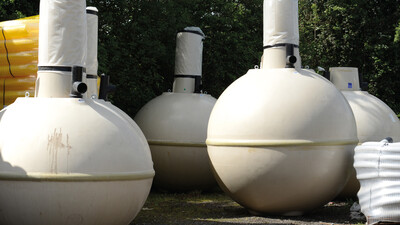If you have a property with an existing septic tank that needs replacing or would like to install a septic tank for a new or converted property and would like to do the work yourself, this step-by-step guide will make your project run more smoothly.
If you are confident you’ve got the skills, strength and determination, a DIY approach could potentially save you quite a bit of money. However, unless you are extremely confident we would always recommend hiring a professional contractor to install your septic tank. There are also legal factors that need to be considered, so we recommend you first research this thoroughly.
You will also need to carry out or commission a thorough site survey to ensure the position of the septic tank and drainage field and the soil type all comply with regulations, and get both Building Regulations approval and consent of discharge from the Environment Agency.
Still keen on giving it a go? Okay, well let’s start.
Prepare to install your septic tank
When your septic tank is delivered, check it carefully for any signs of damage. While it will have been thoroughly inspected before despatch, septic tanks can sometimes suffer during loading, transportation and unloading. Once it has been installed, a supplier is less likely to entertain a damages claim.
Having confirmed your septic tank is undamaged, double-check the depth of your incoming pipework and the invert levels of the tank to ensure the tank that has been delivered will connect with your pipework while sitting within the maximum permissible depth.
Carefully read the installation guide provided by the septic tank manufacturer. I know it’s tempting to work it out as you go along, but this will save you headaches, frustration and costly mistakes.
Excavate for your septic tank
Unless you’re feeling fit and working with light soil, you’ll probably want to hire a mini excavator to dig the septic tank pit. It’s also a good idea to have a pump available to remove groundwater as you’re excavating, particularly if the site has a high water table or it’s a damp time of year.
The size of the hole should be sufficient for the tank and any recommended backfill. You will also need to allow for the pipework to fall between the house and the tank, particularly if you are using a gravity system. The fall ratio will typically be somewhere between 1:60 and 1:70.
Lay a base for your septic tank
Having excavated and levelled the hole, you will need to create a solid base for the septic tank to stand on. this will increase the tank’s stability and reduce any strain that may be put on it during operation. Refer to the manufacturer’s instructions for a suitable base type and thickness.
Position your septic tank
Care must be taken when lowering the septic tank into the hole, as damage can easily occur at this point. One method might be to excavate a temporary slope at one end of the hole so the tank can be slid down into position. If using machinery to position the tank in the hole, make sure it is suitable for the task and that the tank is securely strapped to the machine during movement.
Once the tank is in the hole, check it is level and the inlet and outlet connectors are correctly oriented.
Connect your septic tank
Once all is correct, connect your septic tank to the pipes running from your house and to your septic drainage field. If you are unsure about anything at this point, we strongly recommend calling in a professional plumber to inspect your work, as it will be very expensive to rectify later!
Fit an access cover to your septic tank
In most instances, a septic tank will be located away from any roads or driveways but if not, check with Drainfast that the manhole cover you are using is compatible – the last thing you want is to have a vehicle sink into your septic tank.
Backfill your septic tank
As you backfill around your septic tank, gradually fill the tank with water to keep pace with the level of the backfill. This will weigh the tank down to prevent it from floating as you backfill while protecting it against caving in with pressure from the backfill.
Concrete, sand and gravel are materials commonly used to backfill around a septic tank; your manufacturer’s instructions may recommend a specific material. If your site has a high water table you may need to use a backfill material that will counter the buoyancy of the tank. If the tank is situated under or near a road or driveway, this must also be allowed for in the choice and specification of backfill.
We hope you have found this information helpful and interesting. If you have any further questions you are always welcome to call the friendly team of drainage experts at Drainfast on 01420 555600 or email [email protected].
Also, look out for more articles in our ongoing series of blog posts, bringing you useful information, insights, guides and tips on all things drainage!

Written by
Bob Stone
Technical Sales
Heading up our Technical Estimating Department, Bob is our in-house quantity surveyor.

